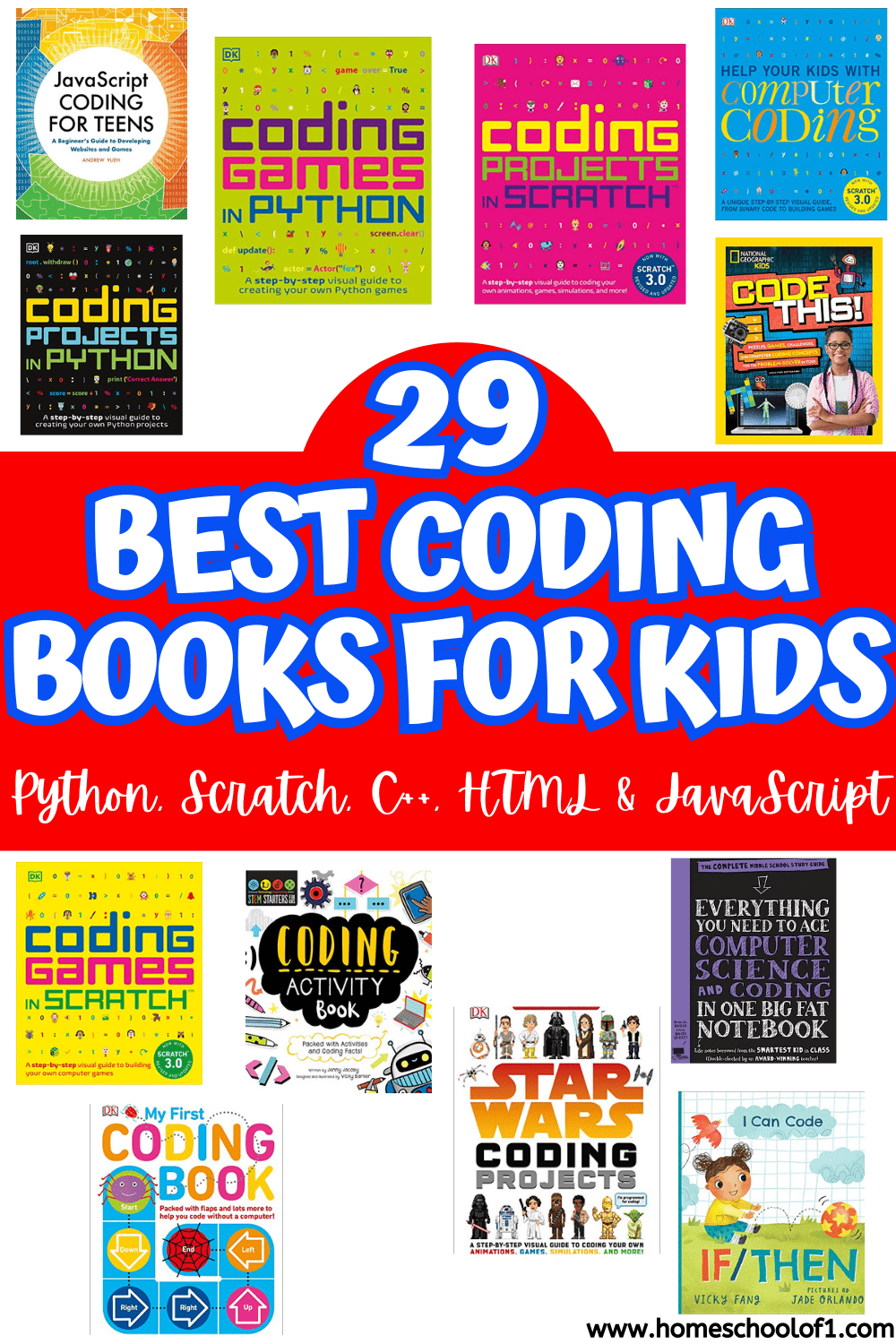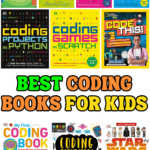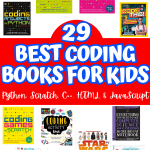29 Best Coding Books for Kids by Age and Skill Level
The best coding books for kids make learning to program fun and accessible, no matter their age or experience.
From simple picture books for preschoolers to hands-on guides that teach Python and Scratch, there’s something here for every young coder.
We’ve gone through quite a few of these ourselves over the years—some were hits, others not as much.
This list focuses on the ones that truly help kids understand coding in a way that clicks.

**This post may contain affiliate links. As an Amazon Associate and a participant in other affiliate programs, I earn a commission on qualifying purchases.**
Books for Kids Who Want to Learn Coding
This hand-picked selection includes coding books that introduce kids to a variety of languages—like Scratch, Python, JavaScript, HTML, and C++.
Many of these pair well with free coding websites for kids, giving them a chance to try out what they’re learning through interactive, hands-on practice.
The list is organized by age, starting with simple board books and moving up to more advanced guides for teens. Whether your child is just beginning or looking to build on what they know, these books offer a range of engaging ways to learn.
They’re also great gift ideas for kids who are curious about how technology works or who enjoy creative problem-solving.
This sweet board book introduces coding through simple if/then statements that toddlers can understand—like “If I’m tired, then I sleep.” It doesn’t dive into programming, but it plants the seed by teaching basic logic through everyday situations. It’s a gentle, age-appropriate way to get your little one thinking like a coder.
We used this book when my son first showed an interest in how computers work. It’s full of colorful activities that walk through Scratch basics in a super approachable way. The puzzles and games feel more like play than learning, which is perfect for younger kids who aren't quite ready for screens.
This one is interactive, with flaps to lift and puzzles to solve—sort of like a hands-on intro to logic. It covers loops, conditionals, and basic sequencing, all without a computer. If your child likes solving problems and figuring out patterns, this book will keep them engaged while laying the groundwork for real coding later on.
A fun mix of screen-free activities—word searches, mazes, challenges—that all tie into coding and logical thinking. It's a great quiet-time option or something to throw in a bag for on-the-go learning. It introduces key concepts in a really low-pressure way.
Instead of teaching kids how to code, this book shows them why coding matters. It tells a story about how people can use coding to solve problems and help others. It’s inspiring and makes the idea of learning to code feel meaningful, which is great motivation for kids just starting out.
This one was a hit in our house thanks to the Star Wars theme. It teaches Scratch projects like animating BB-8 or designing space battles. If your child is more into Star Wars than coding, this book is a clever way to bring both together and get them excited to try it out.
Check out even more educational Star Wars activities.
For kids ready to move beyond block coding, this book introduces JavaScript in a way that doesn’t feel overwhelming. It covers all the basics—variables, loops, functions—with real examples. It’s written in a friendly, approachable tone that helps kids feel confident jumping into a new language.
This book takes a comic-style approach to teaching HTML and CSS, which makes it super approachable—especially for visual learners. It follows a fun adventure storyline while gradually teaching kids how to build their first webpage. If your child is interested in how websites work but isn’t ready for a super technical book, this strikes a nice balance.
Another one from the QuestKids line, this one zooms in on Scratch and teaches kids how to build their own platform games. It’s project-based and has a fun, quirky tone that keeps kids entertained. My son loved trying to recreate some of the game ideas and then tweaking them to make his own versions.
This is a favorite for kids who are ready to start building full projects. It includes 20 different game tutorials using Scratch, and while some are a bit more advanced, the step-by-step visuals make it feel doable. It’s great for kids who are starting to feel confident and want to make their own games from scratch (pun intended).
If your child is obsessed with Minecraft, this is a clever way to sneak in some real coding skills. It uses Scratch to show kids how to build their own in-game mods and experiences. The Minecraft theme really keeps them engaged, and it works well for kids who prefer creative play over structured lessons.
This one is visually clean and well organized—perfect for kids who like following a clear path. It walks through how to make animations, games, and simulations using Scratch. We found the pacing just right for upper elementary kids who want to create something real but still need a bit of guidance.
Similar in style to the previous book, but this one focuses entirely on game creation. It’s structured around different game types (platformers, racing games, etc.), so kids can pick what they’re most excited about. The visuals are helpful and the projects are genuinely fun to play once completed.
This one introduces Python in a very hands-on way, with lots of bite-sized activities and mini-games. It’s a good pick for kids who are ready to move beyond Scratch and try text-based coding but still want a playful experience. The tone is light, and it doesn’t assume any prior knowledge.
This one stands out because it walks through more creative Scratch projects but also explains the “why” behind the code. It helps kids go from copying to actually understanding what they’re doing. It’s great for kids who like to customize things and explore their own ideas beyond the instructions.
What makes this one different is that it doesn’t require a computer at all. It’s full of unplugged activities that teach the logic behind programming—like algorithms and loops—through games, puzzles, and problem-solving. It worked well for us on long car rides or as a screen-free break between online lessons.
This guide covers a bunch of different coding languages, so it’s good for kids who are exploring what they like. It’s a bit more technical than some others on the list but still accessible. If your child wants to try building games, apps, and websites, this gives them a little taste of everything to see what sticks.
We love this one as a reference book—it’s like having a friendly tutor in a notebook. It covers both coding and computer science basics (things like hardware, software, binary, and more) and is perfect for middle schoolers who want to understand the bigger picture, not just the code.
This is a puzzle book more than a guide—it’s filled with brainteasers and challenges that teach kids how to think like a programmer. If your child enjoys logic games or riddles, they’ll have fun with this. It also helps build problem-solving skills that apply directly to coding later on.
This one’s ideal for kids ready to move on from block-based coding and start using a real programming language. The projects are fun—like building quizzes or simple games—and they walk through each step clearly. If your child is curious about how to write actual code but still needs guidance, this book hits a sweet spot.
This is more of a visual reference book, and we found it really helpful as a companion to hands-on guides. It explains concepts like variables, loops, and algorithms with colorful diagrams and examples. It doesn’t have a lot of projects, but it’s great for making tricky ideas easier to understand.
If your child loves gaming and wants to create their own, this book is a solid choice. It teaches Python by guiding them through actual game builds, complete with graphics and player interactions. It’s a bit more advanced, but for kids who are motivated, it’s a fun way to learn real programming skills.
This is a deep dive into everything Scratch can do—from creating art and animations to designing more complex projects. It’s perfect for kids who have already dabbled in Scratch and want to go further. There’s enough challenge here to keep older kids interested while still being easy to follow.
This puzzle-packed workbook teaches the thinking behind coding without using a screen. With mazes, patterns, and logic games, it’s ideal for younger kids who are curious but not quite ready for a programming language. We liked using it during quiet time or as a fun, educational break from the computer.
This one’s a full project guide that teaches HTML, CSS, and JavaScript while helping kids build a website, app, and game. It’s practical and hands-on—each project builds on the last. If your child wants to create things they can actually share or show off, this book delivers that experience.
Related: Coding kits for kids
What I liked about this book is how clearly it explains Python syntax and structure. It includes fun mini-projects and little challenges that build confidence. It’s a good fit for kids around 10+ who are ready to move beyond visual coding and want to type real code.
This one’s definitely for kids who already have some coding under their belt. It introduces C++ through fun, small projects and puzzle-style exercises. C++ isn’t the easiest starting point, but this book makes it more approachable and turns it into a bit of a challenge—which might be just right for the right kind of learner.
This is a big-picture guide that covers several languages and walks through how to create apps, games, and websites. It’s written in a friendly, casual style and breaks down complicated ideas into manageable chunks. If your child isn’t sure where to start or what language to try, this book gives a helpful overview.
A great pick for older kids or teens who are ready to build websites or browser-based games. It focuses specifically on JavaScript and walks through building interactive web features. The tone is teen-friendly and straightforward, and it’s a solid next step after Scratch or Python.
Last Updated on 8 April 2025 by Clare Brown































